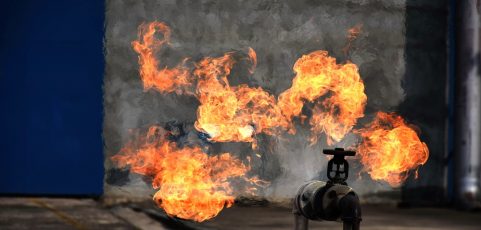What exactly is flammable gas? If your industry handles combustible or toxic gases on a daily basis, you know the importance of minimizing the risk of fire or explosion. Become an expert in your field by understanding the facts behind flammable gases in your warehouse.
The Truth Behind Flammable Gases
A gas is considered flammable if it has the potential to explode or ignite when mixed with oxygen. In other words, if a certain level of flammable gas were to leak into the air, it could result in a fire. The most popular flammable gases are ammonia, butane, carbon monoxide, hydrogen, methane, and propane. Depending on your background, these flammable gas facts might be surprising.
- Chlorine Trifluoride is the most flammable gas
- Oxygen doesn’t start fires or explosions
- Not every flammability limit is the same
1) Chlorine Trifluoride is the most flammable gas
Of all the dangerous chemical gases, chlorine trifluoride is known to be the most flammable. It is a colorless and extremely reactive gas that can burn through concrete and gravel. The high flammability nature of chlorine trifluoride is due to its ability to burn without any ignition source, giving it the ability to exceed the oxidizing power of oxygen. In the few cases that the chemical has been used, it has caused massive explosions and been the source of multiple casualties.
2) Oxygen doesn’t start fires or explosions
Unlike what is commonly misunderstood, oxygen cannot cause an explosion or flash of fire. In order to start a fire, you need three elements: a source of ignition (heat), a combustible material (fuel), and oxygen (air). Moreover, while the presence of oxygen doesn’t start fires, it is necessary for flammable or combustible materials to burn.
3) Not every flammability limit is the same
In order for a chemical gas to ignite, the concentration limit in the air must be within a certain range. That range is known as the flammability limit. Depending on the flammable and combustible liquids or gases you’re using, that range can vary greatly.
To understand the flammable limit for a specific gas, you must know its’ LEL and UEL values. A concentration value below the lower explosive limit (LEL) is considered too lean to burn. In comparison, a gas or vapor exceeding the upper explosive limit (UEL) would be considered too rich to burn. That being said, the range of flammability is the concentration level that lies between the LEL and UEL values of the chemical gas.
Pro Tip: If a chemical gas exceeds its LEL value, it can quickly become an explosion hazard. Protect your business from combustible gases by installing an accurate gas detection system.
Detect Fuel Gases in Houston
Regardless of your industry, it’s crucial for your warehouse or offshore rig to practice routine material safety. Our engineers agree that reliable gas detection is the key to lowering the risk of fire or explosion near you. To guard against flammable gases, install a gas monitor to efficiently check your facility.
What flammable gases do you work with? Share with us on social media!

